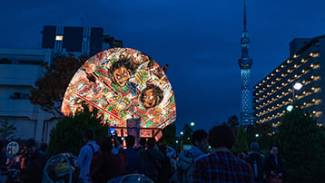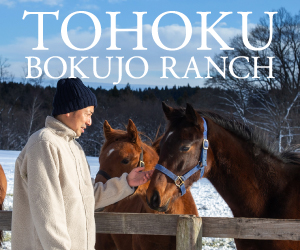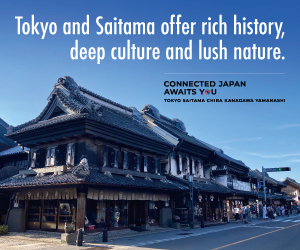NOH
MYSTICAL ART FORM UPS AUDIENCE IMMERSION
Aserene sanctuary divided from the bustle of the surrounding metropolitan Tokyo, the gardens of the Tokyo Metropolitan Teien Art Museum are the venue for this year’s open-air noh event scheduled on Oct. 11 and 12. Organized by Arts Council Tokyo, the Noh Theater in the Garden will offer a rare opportunity for both Japanese and foreign audiences to enjoy the traditional composite art form, with a history of 600 years, on the large lawn of an autumn garden.
Connecting with viewers
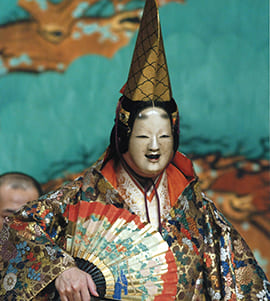
Noh is one of the world’s oldest theatrical arts that is still being performed. The slow-paced, quiet and subdued movements of actors dressed in traditional costumes, along with their noh chants make the performances seem almost like rituals. The masks they wear look stone-faced at first glance, but they change expression from moment to moment based on different angles and shadows. Mystical harmonies are played onstage by a four-piece ensemble of a Japanese flute, drum, shoulder drum and stick drum to accompany the acting. There are only male actors in noh; they play both male and female, young and old characters by changing the tones of their voices, postures and body movements, as well as masks.
The beauty of noh chants lies partly in the classical literary style in which the words are written and spoken, but at the same time, it may make it harder, especially for non-Japanese speakers, to follow the stories.
To help people better understand, there will be a short explanatory presentation in Japanese and English before the performances on both days. There will also be English subtitles on a screen beside the stage to facilitate deeper understanding of each scene.
A hands-on experience
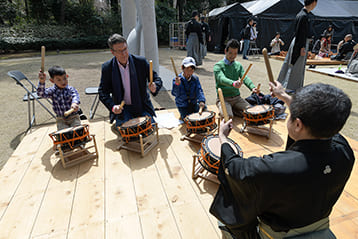
Workshops to be held before the performances will help audience members enjoy the world of noh from various angles. On the first day, participants can touch and take a close look at stage props such as naginata (curved-blade pole weapon) and a spinning wheel that will be used in the performances on both days.
Having minimal stage sets and large props, small props play crucial roles in depicting scenes and actions. A pine tree painted on the back wall of the stage is almost the only stage setting in typical performances played in noh theaters. In the October show, a large, real tree that stands in one corner of the lawn area will substitute the painted tree as the sole feature of the stage settings.
The second day’s workshop allows participants to play the musical instruments used in noh performances. Professional noh music performers will offer lessons on how to play them. “It’s very difficult to produce the correct notes from the four musical instruments, so I hope the participants will appreciate the experienced techniques of the players in the performance later on,” said Takehito Tomoeda, a noh actor of the Kita school.
Active storytelling
On the first day, a noh masterpiece, the tragic story of “Kurozuka” (“Black Mound”), will be performed. It is an emotional story of the solitary life of an ogress in the mountains. One night, a group of yamabushi, or mountain ascetics, looks for a place to sleep and finds a house where a woman lives alone. She kindly offers overnight shelter and says she will go out and get some firewood. As she leaves the house, she warns the visitors not to open the door to her room, but one of the monks opens it anyway. Inside, they find a pile of dead bodies and realize the woman is an ogress. She tries to attack them, but they barely manage to protect themselves with the help of Buddha.
“The story depicts the sadness that leads to malice. Disconnectedness eats away at people’s minds and pushes them to the edge,” said Tomoeda.
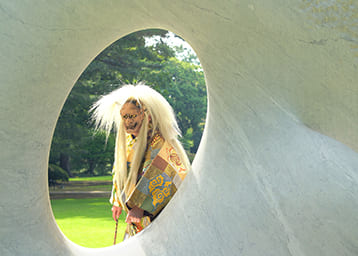
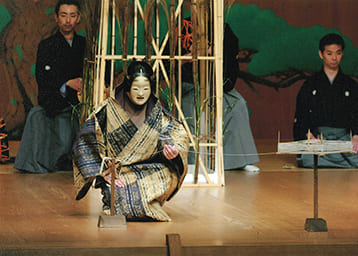
The second day’s performance is “Funa-Benkei” (“Benkei in a Boat”), which is about the escape of Minamoto no Yoshitsune, a renowned general of the Minamoto clan, from a mistrustful brother. As Yoshitsune and his best subordinate, Benkei, sail on the Seto Inland Sea, the ghost of Taira no Tomomori, killed by Yoshitsune in a previous battle, suddenly appears and fiercely attacks them. Benkei’s prayers eventually calm the vengeful spirit and the ghost disappears into the ocean depths. “What makes the storytelling of noh unique is that the main characters are often not historical heroes,” Tomoeda said.
The story of “Kurozuka” takes place in a mountain, while “Funa-Benkei” is set in the ocean. “Even without stage settings or large props, the stage can turn into a mountain or sea just by the movements, actions and voices of the actors who control the space. I hope there will be many people in the audience who will watch both shows to enjoy the difference,” said Tomoeda.
Noh performance details
Kurozuka — Friday, Oct. 11, 2019, 7 p.m. (Workshop starts at 6 p.m.)
Funa-Benkei — Saturday, Oct. 12, 2019, 2:30 p.m. (Workshop starts at 1 p.m.)
Venue: Gardens of Tokyo Metropolitan Teien Art Museum (Outdoors)
5-21-9, Shirokanedai, Minato-ku, Tokyo
*In case of rain,scheduled to be held at Kita Noh Theater
4-6-9,Kamiosaki,Shinagawa-ku,Tokyo.
Ticket prices: All seats reserved, adults ¥3,000, students ¥1,500
Ticket sales:
Confetti (English) http://confetti-web.com/nohtheater
Tel: 0120-240-540 (10 a.m.-6 p.m. on weekdays)
Peatix (English) https://2019teiennoh.peatix.com
Booth info: Tickets Today (English) https://ticketstoday.jp/lineup/en/nohtheater
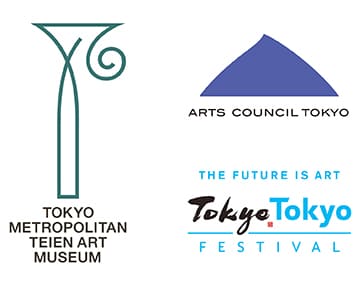
Inquiry:
Tokyo Tradition Office, Arts Council Tokyo
Tel: 03-5428-3655 (10 a.m.-6 p.m.)
Mail: [email protected]
http://www.tokyo-tradition.jp/2019/eng/program/036/ (English)
Organized by Arts Council Tokyo, Tokyo Metropolitan Foundation for History and Culture
Co-organized by Tokyo Metropolitan Teien Art Museum, Tokyo Metropolitan Foundation for History and Culture
Supported by and in cooperation with Tokyo Metropolitan Government
Produced by the Roppeita XIV Commemorative Foundation




